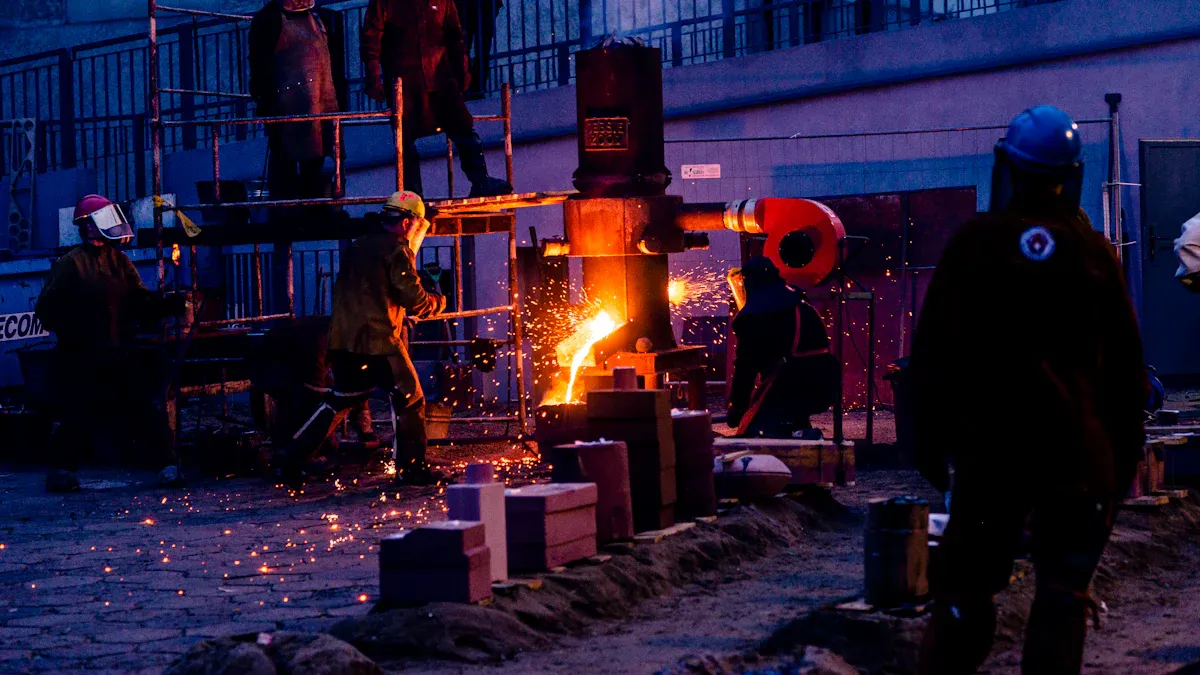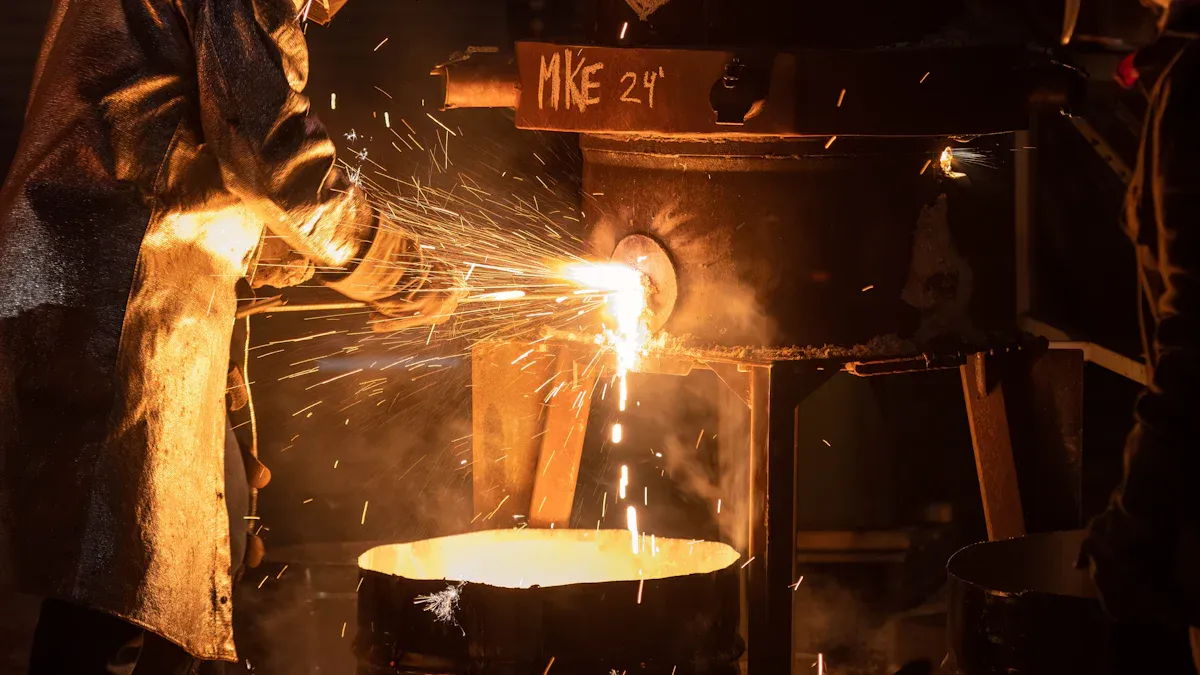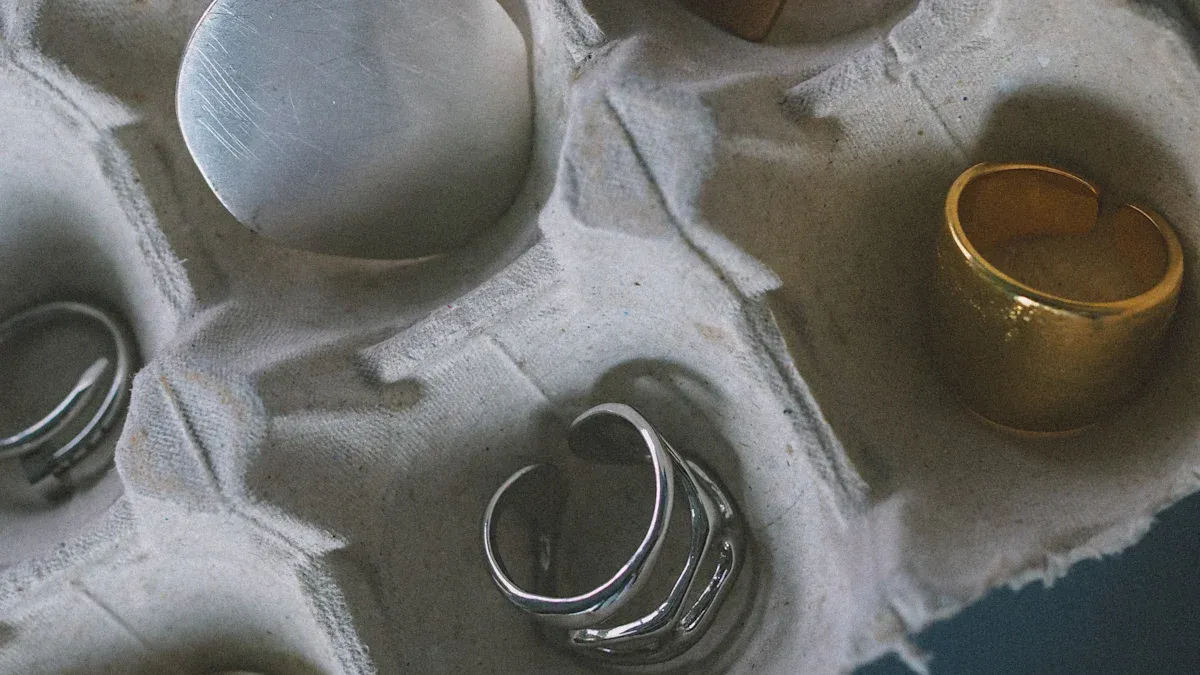
About us: We specialize in the precision manufacturing process of investment casting. This advanced technique allows us to create complex metal products with exceptional detail and accuracy. Our expertise in the investment casting procedure enables us to produce intricate parts, making us a valuable partner across numerous industries. The global investment casting market, valued at USD 23.01 billion in 2024, underscores the significant role of this technology. Experts project this market to grow at a compound annual growth rate of 5.4% from 2025-2035. For more information on how our investment casting solutions can benefit your projects, please contact us.
Key Takeaways
- Investment casting, also known as the “lost wax” process, makes complex metal parts with great detail. It uses a wax model covered in ceramic, then melts the wax away to create a mold for liquid metal.
- This method offers many benefits. It creates parts with smooth surfaces and exact sizes. It also works with many types of metals and reduces the need for extra work after casting.
- The investment casting process has several steps. These include making a wax model, building a ceramic shell around it, melting out the wax, pouring in molten metal, and then finishing the final metal part.
What is Investment Casting?

The “Lost Wax” Principle
Investment casting, also known as the “lost wax” process, has a rich history. People first used this ancient technique around the fourth millennium BC. Archaeological records show its use in various regions. Before this method, people made basic tools from molten copper using simple stone or clay molds. The lost wax method allowed them to create more complex metal objects. For example, decorative copper items from the Nahal Mishmar hoard in Southern Palestine date back to 3700 BC. Other early pieces have been found globally, including in Europe, the Middle East, Asia, Africa, and the Americas. West African sculptors also cast brass using this technique centuries before European explorers arrived.
The core idea behind investment casting is quite clever. First, workers create an accurate model of the desired part using a fusible material, usually wax. This wax pattern forms the initial shape. The term ‘investment’ refers to surrounding an object with a layer of material. In this case, the wax pattern gets encased in refractory material. This forms a ceramic shell mold. The model’s surface is coated with multiple layers of refractory paint. These materials include silica, alumina, and zircon, often held together by binders like ethyl silicate or colloidal silica. After drying and hardening, a strong shell forms around the wax.
Next, they melt the wax mold by heating it. This leaves a cavity inside the ceramic shell. This step is why people call it “lost wax.” The shells are then roasted at high temperatures. This increases their strength and removes any impurities. Molten metal is then poured into this cavity. After the metal cools and solidifies, workers break away the ceramic mold. This reveals the final casting. The investment casting procedure involves these precise steps to achieve detailed parts.
Key Characteristics and Advantages
Investment casting offers many unique characteristics and advantages. It stands out from other manufacturing methods. For example, it produces components with intricate details and high precision. This capability is crucial for industries like aerospace. The process also minimizes defects. This leads to smoother production, fewer adjustments, and lower overall costs. It also reduces waste. It needs minimal post-production finishing. This significantly cuts down on material waste, labor expenses, and promotes environmental sustainability.
Compared to sand casting, investment casting provides superior surface finish and dimensional accuracy. The ceramic shell mold creates parts with smooth surfaces and tight tolerances. Sand casting often results in a rougher surface and lower accuracy. Look at this comparison:
| Feature | Investment Casting | Sand Casting |
|---|---|---|
| Surface Finish | 125 Ra (as cast) | 250 Ra (as cast) |
| Tolerance Control | 0.005”/inch | Poor |
| Machining Required | Greatly reduced | Extensive |
Investment casting also produces parts with fine detail, excellent surface finish, and tight tolerances. Die casting also offers high dimensional accuracy. However, sand casting is better for larger parts where extreme precision and a perfect surface are not essential. Investment casting greatly reduces the amount of machining needed after casting.
Investment casting can produce highly intricate parts with complex internal geometries that are difficult or impossible to achieve with other processes.
This method excels at creating highly intricate parts. It can form complex internal geometries. Other processes find these shapes difficult or impossible to achieve. It delivers near-net-shape products. This significantly reduces the need for secondary machining or finishing. Ultimately, this saves on production costs. You can combine multiple wax patterns to create one unique mold. This allows for parts you could not make with a machine or tools. It becomes a worthwhile alternative to weldments.
Investment casting also supports a wide range of metals and alloys. This offers great flexibility for different applications. Common materials include:
- Steel: Stainless steel and carbon steel are strong, durable, and corrosion-resistant.
- Aluminum: This is lightweight and corrosion-resistant. It is often used in aerospace and automotive parts.
- Titanium: Known for its strength-to-weight ratio, titanium is common in high-performance applications. These include aerospace components and medical devices.
- Nickel-Based Alloys: These offer outstanding heat and corrosion resistance. They are frequently used in aerospace engine components.
- Copper Alloys & Superalloys: These specialized materials have unique mechanical, electrical, or thermal properties for precision applications.
The Investment Casting Procedure: Step-by-Step

The investment casting procedure is a detailed process. It involves several precise steps. Each step plays a vital role in creating high-quality metal parts. Let’s walk through each stage.
Pattern Creation and Assembly
The first step in the investment casting procedure is creating the pattern. Workers make a wax pattern that looks exactly like the final product. For small batches, they can machine this pattern directly. For larger runs, they use a metal die to inject wax, based on a 3D CAD model.
After making individual wax patterns, they assemble them. Multiple wax patterns attach to a central wax rod. This rod is called a sprue. This creates a “tree” structure. This tree allows foundries to cast many parts at once. This method helps reduce the cost for each part. The sprue does two main jobs:
- It provides a base to attach many wax patterns. This creates a single mold.
- It acts as a channel. Molten metal flows through it into the pattern cavities.
Assembling the tree requires care. First, technicians visually inspect all wax models. They make sure the models meet quality standards. Then, they carefully weld the wax patterns onto the sprue. They use bonding wax or an electric soldering iron for this. It is important to place patterns correctly. For example, they avoid attaching products too close to the tip or pouring inlet of the wax tree. This prevents issues like surface roughness or gas bubbles. They also keep enough space between products. This helps the metal solidify properly. After assembly, they clean the wax tree with compressed air. This removes any wax chips.
Quality control starts here. Inspectors use Coordinate Measuring Machines (CMMs) to check the pattern’s dimensions. They also look closely at the surface for any flaws. This helps prevent defects in the final casting.
Shell Building and Curing
Once the wax tree is ready, the next step is building the ceramic shell. This shell will become the mold. Workers repeatedly dip the wax tree into a ceramic slurry. This slurry is a mix of fine-grain silica, water, and a binding agent. After dipping, they coat the tree with sand or stucco. They let each layer dry. They repeat these dipping and coating steps many times. This builds a strong outer layer. The shell gets thicker until it reaches the right strength for the casting size.
The ceramic shell uses special materials. These include fused silica, aluminosilicate, zircon, zirconia, and alumina. These materials are chosen for different metal alloys like steel, nickel, or titanium. Binders, like ethyl silicate or water-based solutions, hold everything together.
After applying the layers, the shell needs to cure. Curing means drying the shell properly. This is very important for the binders to set. They form strong bonds. If the shell does not cure well, it will lose strength. Drying too fast can cause stress and cracks. These defects weaken the shell. Longer curing times usually make the mold stronger. During this stage, workers regularly check the ceramic coating thickness. They also control temperature and humidity during drying. This prevents cracking or warping. They might even use X-ray or ultrasonic testing to find any hidden flaws in the shell.
Dewaxing and Firing the Mold
After the ceramic shell is strong and cured, it is time to remove the wax. This is why people call it the “lost wax” process. Workers heat the shell upside down. The wax inside melts and runs out. Steam de-waxing is one method. Steam drives through the molds. This melts the wax and reduces fumes.
After most of the wax is gone, they fire the shell at very high temperatures. This step is called burnout. Burnout removes any remaining wax. Organic compounds in the wax break down around 450°F. Higher temperatures burn the wax faster. However, too much heat or quick temperature changes can damage the mold. Foundries often soak the shells at 700-900°F for a while. Then, they finish at a higher temperature, usually not above 1200°F. Firing also makes the ceramic shell much stronger. It prepares the mold to hold molten metal.
Metal Pouring and Solidification
Now, the mold is ready for metal. Workers pour molten metal into the hot ceramic shell. The metal fills the cavities left by the wax patterns. This is a critical step. Foundries use several techniques to prevent defects during pouring:
- They degas the molten metal before pouring. This prevents gas bubbles in the final part.
- They use proper venting systems in the mold. This allows trapped gases to escape.
- They optimize the design of the gating system and sprue. This ensures smooth metal flow.
- They control the pouring temperature and speed. This prevents issues like cold shuts or incomplete fills.
- They might use ceramic filters. These filters catch impurities in the molten metal.
Controlling how the metal cools is also very important. This is called solidification. The cooling rate affects the metal’s grain structure. Fast cooling creates smaller grains. This usually makes the metal stronger and harder. Slower cooling leads to larger grains. This can make the metal more ductile but less strong. Controlled solidification helps minimize defects like porosity (trapped gas) and shrinkage (metal contracting as it cools). Engineers use mold design, cooling channels, and even special techniques like directional solidification to manage cooling rates. This ensures the final part has the right strength and properties.
Throughout this stage, quality control is strict. They use spectroscopy to check the metal’s chemical makeup. Thermal cameras and infrared sensors precisely control pouring temperatures. This prevents shrinkage flaws.
Finishing and Inspection
Once the metal cools and solidifies, workers break away the ceramic shell. This reveals the metal tree structure. They then cut the individual parts from the tree.
After cutting, parts often need more work. These are finishing operations. They include:
- CNC Milling: Uses computer-controlled tools to shape complex parts.
- Grinding: Uses abrasive wheels for high precision and smooth surfaces.
- Drilling: Creates precise holes.
- Polishing and Deburring: Makes surfaces smooth and removes sharp edges.
Machining is very important. It refines the cast parts. This ensures tighter tolerances and better surface finishes. It helps achieve specific shapes that casting alone cannot perfectly create.
Finally, every part undergoes thorough inspection. This ensures quality and accuracy. Common inspection methods include:
| Method | Purpose |
|---|---|
| Visual Inspection | Detects surface defects like cracks or roughness |
| Dimensional Inspection | Measures part dimensions with tools like CMMs |
| Radiographic Testing (X-ray) | Finds internal defects like porosity or cracks |
| Ultrasonic Testing | Identifies subsurface defects |
| Magnetic Particle Inspection | Detects surface defects in magnetic materials |
| Dye Penetrant Inspection | Finds surface cracks |
| Chemical Composition Analysis | Verifies the metal alloy’s makeup |
| Mechanical Property Testing | Checks strength, hardness, and impact resistance |
These inspections ensure the investment castings meet all required specifications. They confirm the parts are strong, accurate, and free from defects.
Benefits, Materials, and Applications
Advantages of Investment Casting
Investment casting offers many benefits for manufacturing complex parts. It provides great design flexibility. This allows for intricate features like thin walls, sharp corners, and internal cooling passages. Manufacturers can create elaborate designs that other methods find difficult. This process often eliminates the need for secondary machining. Parts come out with precise dimensions and fine details. This leads to smoother finishes and tighter tolerances. The investment casting procedure helps produce net-shape products. This reduces post-processing and saves time and effort. While initial setup costs can be higher, larger production runs become very cost-effective. This is because it minimizes machining and material waste.
Common Alloys and Material Versatility
Investment casting works with a wide range of materials. This includes both ferrous and non-ferrous metals. Common choices include stainless steel, known for its durability and corrosion resistance. Aluminum is popular for its light weight and strength. Carbon and low-alloy steels offer strength and cost-effectiveness. Superalloys, like nickel and cobalt-based options, withstand extreme temperatures and wear. Copper alloys, such as brass and bronze, provide excellent conductivity and corrosion resistance. Cast iron is also used for its affordability and heat resistance. This material versatility allows manufacturers to pick the best material for specific needs, whether for high strength, corrosion resistance, or thermal properties.
Industries and Applications
Many major industries rely on investment casting for critical components. The medical industry uses it for knee replacement implants, surgical instruments, and diagnostic equipment. The defense industry benefits from its precision for firearm parts, missile components, and radar housings. In the energy sector, investment casting creates turbine blades, valve components, and pump casings. Aerospace applications include Inconel 718 turbine blades and titanium brackets. The automotive industry uses it for durable stainless steel turbocharger housings and precise transmission gears. This method ensures high reliability and tight tolerances across these demanding fields.
Investment casting consistently delivers complex, precise components with excellent surface finish and high integrity. It’s the ideal choice for design freedom, significantly reduced machining, and when specific material properties or intricate internal features are crucial for your part. This method ensures quality and consistency across various production volumes.
FAQ
What is the main advantage of investment casting?
Investment casting creates complex parts with high precision and excellent surface finish. It allows for intricate designs and reduces the need for extra machining. This process delivers near-net-shape products.
What materials can investment casting use?
This process works with many materials. It uses ferrous and non-ferrous metals. Common choices include steel, aluminum, titanium, and nickel-based alloys. This versatility helps meet diverse application needs.
Is investment casting a cost-effective process?
Initial setup costs can be higher. However, investment casting becomes very cost-effective for larger production runs. It minimizes machining and material waste. This saves money in the long term.
